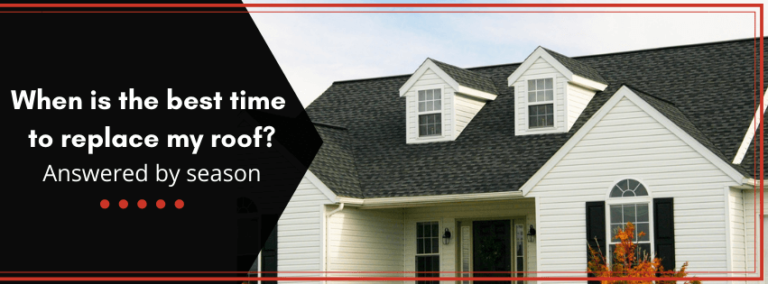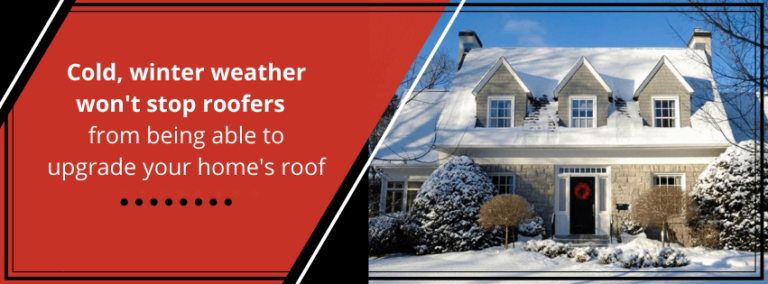
You’re thinking it’s time to replace your roof (or your leaking roof is telling you that it’s time). No matter the size of your home, this is an important decision that shouldn’t be made rashly. You want to make sure that you’re choosing the right contractor to install the roof, it’s installed properly, and that the weather cooperates during the replacement process.
Fall is considered the best season to replace your roof!
Changing seasons can largely impact many factors of your roof replacement – rain, snow, heat, humidity. These weather conditions could also affect how quickly your job can be completed. Aside from weather, you also must consider the ease of securing a spot on the roofing crew’s schedule because their availability and greatly vary. We’ve considered each season’s benefits and drawbacks for roof installation so you can determine which is best for you!

Fall (September, October, November)
*Cue the pumpkin spice*
You can finally stop sweating on the walk to your car. The transition to cooler temperatures produces a prime time for roof replacements. Fall is considered the best time to replace your roof and here’s why:
- Comfortable temperatures (for the crew and shingles!)
- Mild Weather
- Timing
Temperatures range from 45 and 85 degrees which allows for better working conditions for roof installers, allowing them to complete your job in a timely fashion. Fall may bring more precipitation than summer as some storm seasons are still in effect, but for the most part, rain delays are less likely to be an issue the earlier in fall you start. Perfect temperatures with lower humidity and less rain allows your shingles the time they need to effectively seal prior to entering the snowy months.
Cons of Fall Roof Replacement
With perfect roofing weather conditions in the fall and homeowners’ last chance to fix their roof before winter steps in, typically this is a very busy time. Because summer is a packed season, summer jobs can often spill into the fall months, so this means you may not be able to get your roof replaced next week. That being said, installers can work longer hours with less weather day delays during the summer and fall allowing jobs to be completed faster than anticipated and the contractor’s replacement schedule can remain on time.
If you’re thinking fall is going to be the season you want to have your roof replaced, make sure to plan ahead about 1 to 2 months in advance. Get ahold of roofing contractors to get a quote and get on the schedule so your spot is reserved for this prime season.

Spring (March, April, May)
The gradually warming weather begins the foot race of attempting to complete your home improvement to-do list. If you experienced any issues through the harsh winter, you likely have replacing your roof at the top of the list.
Springtime is a great season to tackle reroofing your home! Many professionals would say spring is the the second best season to replace your roof due to a few reasons:
- Open schedule
- Lower humidity
Roofing companies aren’t slam packed yet as typically business is a little slower in the winter, so they’d be able to get you in sooner rather than later. This is a big task you’d be able to check off your list and allow you to enjoy your summer, leak free!
The weather is much more mild than winter as we start having more sun and less snow. The spring months are typically accompanied by lower humidity than summer which lessens the possibility of moisture damaging the roof during the replacement.
Cons of Spring Roof Replacement
While you could get on the roofing crew’s schedule a little sooner, weather does tend to be wetter, especially in south central Pennsylvania. This could cause your project to be pushed back slightly due to rain. However with most companies, this delay only tends to be a day or two depending on if other projects were also moved due to weather.

Summer (June, July, August)
The sun is shining, the days are long, and the weather is hot! Summer is the most popular season to replace your roof thanks to the highest likelihood of clear weather. Summer is a fair season to replace your roof because:
- Consistent & warm weather
- Rain later in the day (if any)
The earlier in the summer, the better. This is when humidity is going to be lower, the weather isn’t going to be quite as unbearable, and the extreme summer storms haven’t hit yet. If you install the roof earlier, you could even save some money in the long run with being more energy efficient!
In the summer, the sun produces an abundant amount of heat for the tar strip on the back of asphalt shingles to activate and adhere properly. This can help prevent any future fly offs or leaking!
Cons of Summer Roof Replacement
If you wait until peak summer, the conditions aren’t going to be as fair. The extreme heat can make for unworkable conditions (your roof can be up to 20 degrees hotter than the temperature on the ground!). These intense temperatures can also impact the installation of your roofing materials because the asphalt shingles could soften, making them less durable and more prone for damage during installation.
Because of the popularity of this season, it’s also going to be harder to get a quick scheduling turnaround time. From the inspection visit to the crew stepping onto your property, it could be a significantly longer wait time than other seasons.
Winter (December, January, February)
The snow, cold, and ice won’t completely stop roofers from upgrading your home’s roof! The winter season comes with its specific challenges, but if done correctly, you are able to upgrade your home’s roof in the cold weather. The biggest benefit to installing your roof in the winter is:
- Roofer’s availability
Winter is the least busiest season for roofing companies. As long as weather conditions permit, you could get on the schedule quicker than any other season. This may be good if you’re experiencing issues!

Cons of Winter Roof Replacement
If you’re thinking about installing asphalt shingles, you especially may want to wait until the temperature warms. The cold weather causes the shingles to lose some flexibility, becoming more difficult to cut and insert the nails.
Shingles also have a tar sealant on the back that is activated by heat and sunlight, but with limited amounts of both in the winter, the sealing process may not adhere properly. Many roofing companies may supplement with hand-sealing techniques so that your shingles don’t blow off with the wind, however, this could be accompanied by extra labor costs.
The roof installation project may take longer during winter because the days are shorter and the materials are more challenging to put on.
The good news is that you can replace your roof during any season, as long as you choose the right professional to install it. It’s best to talk with a roofing consultant in order to determine which season would be best for your home, depending on the health of your roof, tree coverage, location, and whether you’re looking at asphalt shingles, metal roofing, or solar roofing.
If you’re considering replacing the roof of your home, we’d love to connect with you about the project. Contact us whenever you’re ready to get scheduled for a consultation or give us a call at 717-459-3499!
We can’t wait to help you!
Pennsylvania Home Improvement Contractor License (HIC) # PA124258


